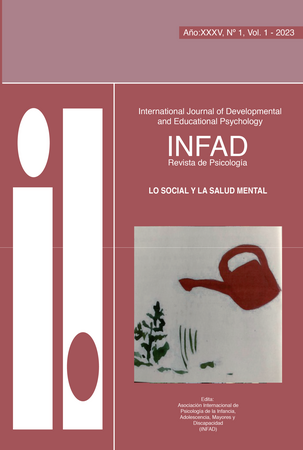Análisis de estrategias didácticas empleadas en adolescentes con barreras para el aprendizaje y la participación
Contenido principal del artículo
Resumen
En el presente artículo se presentan los resultados derivados del avance de la tesis de maestría en ciencias de la educación, acerca de casos de docentes de educación especial, con el objetivo de analizar las estrategias didácticas empleadas en la educación a distancia en adolescentes que enfrentan Barreras para el Aprendizaje, durante la pandemia COVID-19 y el posterior regreso a clases en México, se identifican las experiencias obtenidas, así como las dificultades a las que se enfrentaron los docentes. Mediante una metodología cualitativa, se muestran los primeros resultados obtenidos a partir de las entrevistas realizadas al personal de educación especial. En sus estrategias se encontró que promovieron el trabajo colaborativo, adecuaron su forma de enseñar a las nuevas tecnologías, realizaron ajustes razonables a los currículo para que los adolescentes lograran los aprendizajes esperados, por otro lado reportan que presentaron algunas dificultades como el desconocimiento y dificultades en el manejo de las tecnologías, poco acceso a internet y a aparatos electrónicos, así como una baja participación y falta de interés de parte de los padres de familia. Este primer estudio permite realizar mejoras y obtener una entrevista válida para el estudio final.
Detalles del artículo
Sección

Esta obra está bajo una licencia internacional Creative Commons Atribución-NoComercial-SinDerivadas 4.0.
Aquellos autores/as que tengan publicaciones con esta revista, aceptan los términos siguientes:
- Los autores/as conservarán sus derechos de autor y garantizarán a la revista el derecho de primera publicación de su obra, el cuál estará simultáneamente sujeto a la Licencia de reconocimiento de Creative Commons que permite a terceros copiar y redistribuir el material en cualquier medio o formato bajo los siguientes términos: —se debe dar crédito de manera adecuada, brindar un enlace a la licencia, e indicar si se han realizado cambios. Puede hacerlo en cualquier forma razonable, pero no de forma tal que sugiera que usted o su uso tienen el apoyo de la licenciante (Atribución); — no se puede hacer uso del material con propósitos comerciales (No Comercial); — si se remezcla, transforma o crea a partir del material, no podrá distribuirse el material modificado (Sin Derivadas).
- Los autores/as podrán adoptar otros acuerdos de licencia no exclusiva de distribución de la versión de la obra publicada (p. ej.: depositarla en un archivo telemático institucional o publicarla en un volumen monográfico) siempre que se indique la publicación inicial en esta revista.
- Se permite y recomienda a los autores/as difundir su obra a través de Internet (p. ej.: en archivos telemáticos institucionales o en su página web) antes y durante el proceso de envío, lo cual puede producir intercambios interesantes y aumentar las citas de la obra publicada. (Véase El efecto del acceso abierto).

Este obra está bajo una licencia de Creative Commons Reconocimiento-NoComercial-SinObraDerivada 4.0 Internacional.
Cómo citar
Referencias
Ainscow M. y Booth T. (2000), Índice de Inclusión, Desarrollando el aprendizaje y la participación en las escuelas, Bristol, UK.
ATLAS.ti (2022) Scientific Software Development GmbH. Recuperado de https://atlasti.com/es/research-hub/pasos-para-el-analisis-de-datos-guia-basica
Best J. W (1970), Research in Education Prentice – Hall, Englewood Cliffs, Nueva Jersey.
Booth, T. y Ainscow, M. (2015). Guía para la educación inclusiva. Desarrollando el aprendizaje y la participación inclusiva. España: Organización de Estados Iberoamericanos, FUHEM.
Cohen L y Manion L (2002) Métodos de investigación educativa. La Murralla. Madrid.
Coll C. y Martí E. (1985). Aprendizaje y desarrollo: la concepción genético – cognitiva del aprendizaje.
Denzin y Lincon (2011). El campo de la investigación cualitativa. Manual de investigación cualitativa. Vol. I. Educación Básica”, en Diario Oficial de la Federación, México, 1992.
Guba, E., & Lincoln, Y. (2002). Paradigmas en competencia en la investigación cualitativa. In C. Derman, & J. Haro, Por los rincones. Antología de métodos cualitativos en la investigación social.(pp. 113-145).
Hernández, R., Fernández, C., y Baptista,P., (2014). Metodología de la Investigación. McGrawHill Education. [Archivo PDF]. https://www.uca.ac.cr/wpcontent/uploads/2017/10/Investigacion.pdf
Instituto Nacional de Estadística y Geografía (INEGI) (2020). Encuesta para la medición del impacto COVID-19 en la educación (ECOVID-ED). https://www.inegi.org.mx/contenidos/saladeprensa/boletines/2021/OtrTemEcon/ECOVID-ED_2021_03.pdf.
Mertens, D. (2015). Research and Evaluation in Education and Psychology [Investigación y Evaluación en Educación y Psicología]. SAGE Publications. Secretaría de Educación Pública (1992). “Acuerdo Nacional para la Modernización de la Educación Básica”, en Diario Oficial de la Federación, México, 1992. Disponible en http://www.sep.gob.mx/work/models/sep1/Resource/b490561c-5c33-4254-ad1c aad33765928a/07104.pdf
Secretaría de Educación Pública (1994). Cuadernos de Integración Educativa. No. 3. Declaración de Salamanca de Principios, Política y Práctica para las Necesidades Educativas Especiales, México, Ed. D. G. E. E. /SEP.
SEP. (2011). Modelo Educativo para el Fortalecimiento de Telesecundaria Documento base.
Stake, R. (1999). Investigación con estudio de casos. https://www.uv.mx/rmipe/files/2017/02/Investigacion-con-estudios-de-caso.pdf
UNESCO (2020). Informe de Seguimiento de la Educación en el Mundo 2020 –América Latina y el Caribe–. Inclusión y educación: todos y todas sin excepción [en línea] https://unesdoc.unesco.org/ark:/48223/pf0000374615.
UNESCO. Plataformas y herramientas nacionales de aprendizaje. Disponible en: https://en.unesco.org/covid19/educationresponse/nationalresponses#LATIN%20AMERICA%20&%20THE%20CARIBBEAN.

